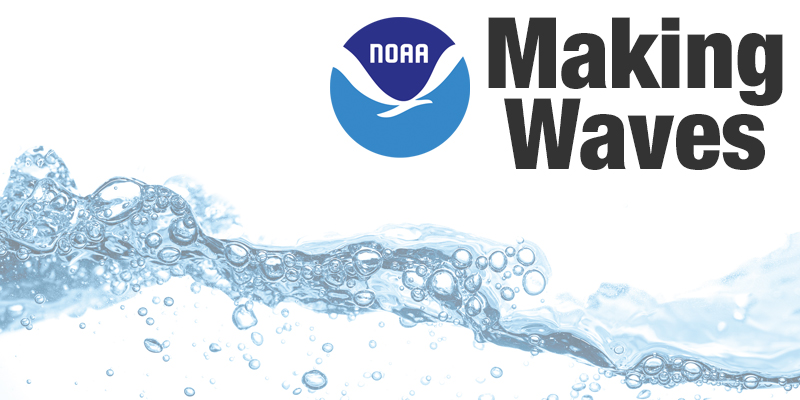How Data Makes a Difference: IOOS® and Safe Ship Navigation
Making Waves: Episode 132
Take a virtual journey to Penobscot Bay, Maine, to see how harbor pilots use U.S. Integrated Ocean Observing System (IOOS®) data for real-time ocean and weather conditions. This information is critical for safe navigation as pilots carefully move tankers and other vessels often carrying dangerous cargo safely in and out of port.
IOOS coastal and marine data (e.g., water temperature, water level, currents, winds, and waves) are collected by many different tools including satellites, buoys, tide gauges, radar stations, and underwater vehicles. Most of the data collected are streamed online and viewable on digital maps for easy access.
Transcript
[Capt. David Gelinas] I’m a harbor pilot up in Penobscot Bay, Searsport, Maine. We're the guys that are responsible for bringing tugboats and tankers safely in and out of the ports of Searsport and and Bucksport, and also we pilot cruise ships that come into the port of Bar Harbor. We use NOAA data daily in our job. I mean time of slack water, time of high water, time of low water. So we rely on NOAA data on a daily basis.
[Capt. David Gelinas] For our work, we’re relying on it to move the big ships — the tankers, the freighters. About 90 percent of the total cargo that we bring into Searsport and Bucksport is oil-related cargo, petroleum products. Anything from gasoline, jet fuel, all the way down to asphalt, heating oil, and Number 6 fuel. So pretty hazardous stuff. We need to handle it with a great level of care. So the more information we have about the weather and the conditions we're going to be going out in with those vessels, the safer the decisions we can make when we’re moving.
[Capt. David Gelinas] Well, the IOOS system is interesting. We got involved with that because the scientists that were behind it said that they thought there was some practical applications and when we heard what they could do in terms of measuring wave height, wind speed, wind direction wave periods ... we were all over that.
[Capt. David Gelinas] That's hugely important information for us to make the determinations about, 'Can we safely go offshore in our small pilot boat to come alongside the big tankers?' 'Is it safe to bring a small tug and barge carrying oil into port or back out to sea in those conditions?'
[Capt. David Gelinas] So that's where IOOS really comes in handy, because you can plan your transits both arrivals and departures, based on what those forecasts are. what the trends are, and what the actual conditions are that you're observing from the buoys.
[Capt. David Gelinas] Before we had this information, we would go offshore and sometimes, despite the advances in technology the forecasts aren't quite what they had said. The nice thing about the IOOS system is that that's real-time. So we go on and see is the forecast right, or are the conditions actually worse than what what they had predicted? And we've had some pretty bad trips over the years where boats have gotten broken because of being out in bad weather.
[Capt. David Gelinas] So it's very important to us to know what those actual conditions are. The forecast is important but what's really happening at that time is more important. You know, if we have an oil barge that's partly loaded with some cargo — gasoline, diesel, jet kerosene — we can look at those buoys and see what the conditions are out there and we know it's not safe, it's a pretty easy sell to the captain to say, 'Hey, you know what? You want to wait 12 hours, it's pretty ugly out now, here's what's happening.'
[Capt. David Gelinas] Our boat that gets us on and off these ships is only about a 47-foot fiberglass based out of Rockland with a Penobscot pilot and Captain Jane Ryan she uses those buoys more than anyone I know in terms of figuring out what's going on offshore."
[Capt. Jane Ryan] "Everybody uses it. it's a wonderful asset all this information, because then we can make decisions we're making informed decisions about lives and property. If we're paying attention. If we pay attention and listen to what the weather reports are, otherwise you're just blind."
[Capt. David Gelinas] "We would be at a huge disadvantage without the IOOS system. Every once in a while, they talk about pulling one or more of those buoys and it really sets off alarm bells in our organization because alarm bells in our organization because literally on a daily basis, we rely on that information to make sound decisions. If it's gone, we can't we can't make the decisions that we need to make with as good information as we have right now. We have a lot of petroleum that moves up and along this coast and the guys that move the vessels We have a lot of petroleum that moves up and along this coast the most up-to-date data.

From corals to coastal science, catch the current of the ocean with our audio and video podcast, Making Waves.
Subscribe to Feed | Subscribe in iTunes